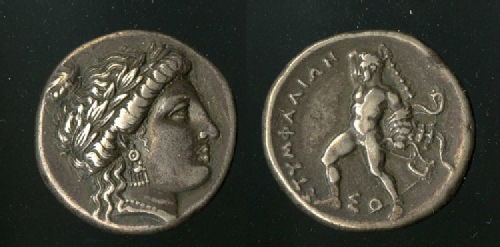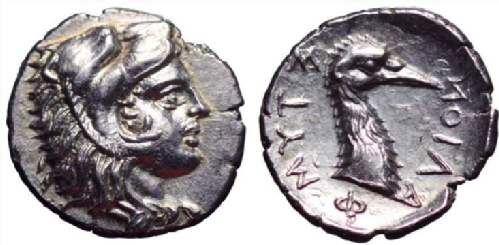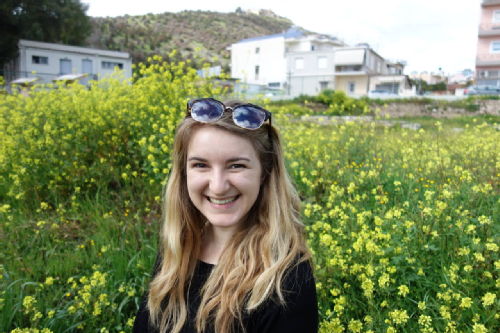All entries for Friday 01 December 2017
December 01, 2017
A stater of Stymphalos
 |
| A stater of Stymphalos, © The Trustees of the British Museum |
Obverse: Head of Artemis (?) with laurel wreath.
Reverse: Nude Herakles; ΣΤΥΜΦΑΛΙΩΝ upwards on left, ΣΟ beneath.
Dated mid fourth century BC, diameter 25mm, weight: 11.75g.
Stymphalos was located near the present-day town of Stymfalia, in a mountain valley in north-west Arcadia. In Greek literature, it is famous as the site of the sixth Labour of Herakles – in which he battled the carnivorous Stymphalian birds. The site was first excavated by Anastasios Orlandos during the 1920s. More recently, excavations by the University of British Columbia (led by Prof. Hector Williams) took place between 1994 and 2001. Amongst the finds were a large quantity of coins – 492 in total – yet of this figure, only five of the coins found were minted in Stymphalos itself.
This coin is a silver stater, minted in the mid fourth century BC. On the obverse, we see a bust of a female deity, crowned with a laurel wreath. This has previously been identified as Artemis, due to the archaeological material pertaining to a female goddess at the acropolis sanctuary at Stymphalos. Archaic figurines found in the excavation are seen holding a small animal in one hand – thought to be a hare – an animal often depicted with Artemis. In addition, references attesting the worship of the ‘Braurion Artemis’ at Stymphalos support the view of there being a sanctuary to the goddess. However, votive offerings found at the sanctuary allude to dedications to Eileithyia, and we know from Pausanias that she was worshipped in the region. Coins at Argos have also been found bearing the portrait of Eileithyia, and so it is not unreasonable to suggest that the deity depicted here could be either Eileithyia or Artemis.
The reverse displays a portrait of Herakles in action: with one hand raised, holding a club, and the other with bow and arrow, with the inscription ‘ΣΤΥΜΦΑΛΙΩΝ’ on the left-hand side. The lionskin that he is usually depicted wearing as a headpiece is instead flung around his left arm. This depiction of Herakles differs from other coins minted at Stymphalos (one is pictured below), where he is shown in portrait style, with an image of a Stymphalian bird in profile on the reverse. It would be safe to presume in this instance, that the two images: Herakles and the Stymphalian bird, have been combined in an active portrait showing Herakles in the midst of battle in his sixth labour.
 |
| Silver obol of Stymphalos, c. 350 BC, 12mm, 0.95g. |
From Xenophon, we know that citizens of Stymphalos were employed as mercenaries at the end of the fifth century and throughout the fourth century BC. This would account for the presence of foreign coinage at Stymphalos, and would perhaps indicate why so little of the city’s own coinage was in circulation – perhaps it was being carried and traded at other cities across Greece. Coins from neighbouring city mints such as Phlious were found at Stymphalos in larger quantities than the local mint, suggesting that Stymphalos only minted currency when necessary, such as in recovery after an attack. Xenophon dates the attack of Iphikrates to 391 BC, but Schaus gives reason for suggesting that if the attack took place, it more likely would have occurred in 370-369 BC. If we take Schaus’ suggestion, then the timing of the attack would seem a reasonable catalyst for the minting of this coin and other from the mid fourth century BC.
Stymphalos was neighboured by Argos, Corinth and Sikyon within a 30 mile radius, and their prominence overshadowed the city. This coin demonstrates a strong regional identity, with mythology interwoven as part of the historical fabric of the city. Distribution outside the city at the hands of mercenaries allows the iconography of this coin to re-establish Stymphalos’ significance in the mythological history of Greece.
 |
This month's entry was written by Alice Clinch, a Masters student in the department of Classics and Ancient History at Warwick. She has worked on fieldwork projects in Greece and Sicily, and is particularly interested in constructed sacred space and ritual activity in cults.
Bibliography
Imhoof-Blumer, F. and Gardner, P. (1885). Numismatic Commentary on Pausanias. The Journal of Hellenic Studies, 50-101.
Robinson, E. (1901). Report of the Curator of Classical Antiquities. Annual Report for the Year ... (Museum of Fine Arts, Boston), 28-72.
Schaus, G. P. (2014). Stymphalos: Ancient Sources and Early Travellers. In G.-L. e. al., & G. P. Schaus (Ed.), Stymphalos, Volume One: The Acropolis Sanctuary (pp. 6-11). Toronto: University of Toronto Press.
Sturgeon, M. (2014). Sculpture. In Garvie-Lok. et. al., & G. P. Schaus (Ed.), Stymphalos, Volume One: The Acropolis Sanctuary (pp. 36-55). Toronto: University of Toronto Press.
Weir, R. (2007). The Stymphalos Hoard of 1999 and the City's Defenses. American Journal of Numismatics, 9-32.
 Clare Rowan
Clare Rowan

 Please wait - comments are loading
Please wait - comments are loading

 Loading…
Loading…